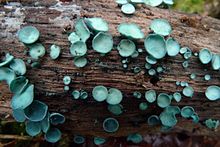Helotiales
| Helotiales | |
|---|---|

| |
| Chlorociboria (Helotiaceae) | |
| Scientific classification | |
| Kingdom: | Fungi |
| Division: | Ascomycota |
| Class: | Leotiomycetes |
| Subclass: | Leotiomycetidae |
| Order: | Helotiales ex Korf & Lizon (2000) |
| Families | |
Helotiales is an order of the class Leotiomycetes within the division Ascomycota.[1] According to a 2008 estimate, the order contains 10 families, 501 genera, and at least 3881 species.[2]
Helotiales is the largest order of non-stromatic discomycetes that usually, but not always, have brightly coloured apothecia. Many members of the family have obviously cup-shaped ascomata with little or no stipes. They are usually found fruiting on coarse or large wood debris aa well as on other organic matter. Part of these discomycetes are limted to a specific host range, this goes as far as to nut just being limited to one particular plant, additionally some species need a particular part of that plant.[3]
Habitat[]
- Helotiales is distinguished by its disc or cup-shaped apothecia.
- Its asci are only slightly thickened in contrast to other Leotiomycetes
- Most Helotiales live as saprobes on soil humus, dead logs, manure and other organic matter.
- The order includes most fungi that engage in ericoid mycorrhiza. Including Rhizoscyphus ericae, Meliniomyces species and Cairneyella variabilis.
- The order contains some of the worst plant pathogens such as Monilinia fructicola (Brown rot on stone fruits), Sclerotinia sclerotiorum ( and other diseases), D. rosae (black spot of roses), Sclerotium cepivorum (Soft rot of onions) and Botrytis cinerea.
Families and Examples[]
- Ascocorticiaceae, saprobiontic funghi, typically found on Coarse woody debris, bark and organic matter.
- Chlorociboriaceae, only have the genus of Chlorociboria, including the bright blue-green cup fungi Chlorociboria aeruginascens, commonly found on decaying oak, and also referred to as Green Elfcup.[3][4]
- Dermateaceae, can be found globally, some of these funghi live saprobiontic, while others live as plant parasites and damage theirs hosts, thus evaluated as a plant disease.
- Helotiaceae, are small disk-shape fungi, some of which damage their host plants, such as the species Pseudopezicula tracheiphila (affecting viticultures
- Hemiphacidiaceae, are parasites, mainly found on pinales
- Hyaloscyphaceae, mostly saprobiontic funghi, such as the 40 species of Lachnellula.
- Loramycetaceae, include two aquatic species: Asperopilum and Macrospora.
- Phacidiaceae, include Bulgariaceae, such as the parasite Bulgaria inquinans.
- Rutstroemiaceae can be found globally, mostly living saprobiontic (example: Rutstroemia).
- Sclerotinaceae, mostly live a parasitic lifestyle. Many of them can damage garden plants, such as the Botrytis family (including Botrytis cinerea) The aquatic discomycete Mitrula, is found in Europe, Asia, and North America.[5]
- Vibrisseaceae, mycologist Richard Korf included the genera Vibrissea, Chlorovibrissea, and Leucovibrissea, when he discribed the Vibrisseaceae in 1990.[6]

Green Elfcup or Green Wood Cup Chlorociboria aeruginascens, family: Chlorociboriaceae
(photo: Holger Krisp)
Ascocoryne, family: Helotiaceae

Mollisia benesuada, family: Dermateaceae

Bisporella citrina, family: Helotiaceae

Arachnopeziza aurata, family: Hyaloscyphaceae

Black Bulgar. Bulgaria inquinana, family: Phacidiaceae

Brown oak disk cup Rutstroemia firma, family: Rutstroemiaceae
(photo: Holger Krisp)
The necrotrophic fungus Botrytis conidiophores, Magnification X16 , family: Sclerotinaceae

Vibrissea truncorum, family: Vibrisseaceae
image source: Mushroom Observer[7]
See also[]
| Wikimedia Commons has media related to Helotiaceae. |
References[]
- ^ Lumbsch TH, Huhndorf SM (December 2007). "Outline of Ascomycota – 2007". Myconet. Chicago, USA: The Field Museum, Department of Botany. 13: 1–58. Archived from the original on 2009-03-18.
- ^ Kirk PM, Cannon PF, Minter DW, Stalpers JA (2008). Dictionary of the Fungi (10th ed.). Wallingford, UK: CABI. p. 310. ISBN 978-0-85199-826-8.
- ^ a b "Helotiales: The non-stromatic Cup Funghi". Mycologywebpages New Brunswick Museum. Retrieved 29 November 2021.
- ^ Kuo M. (2004). "Chlorociboria aeruginascens & C. aeruginosa". Retrieved 29 August 2009.
- ^ Zheng, Wang; Binder, Manfred; Hibbett, David (2005). "Life history and systematics of the aquatic discomycete Mitrula (Helotiales, Ascomycota) based on cultural, morphological, and molecular studies". American Journal of Botany. 92: 1565–74. doi:10.3732/ajb.92.9.1565.
- ^ Korf RP. (1990). "Discomycete systematics today: a look at some unanswered questions in a group of unitunicate ascomycetes". Mycosystema. 3: 19–27.
- ^ "Vibrissea truncorum (Alb. & Schwein.) Fr. (335788)". Mushroom Observer. Retrieved 29 November 2021.
- Helotiales
- Leotiomycetes
- Ascomycota orders








